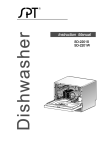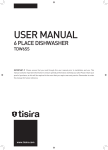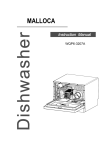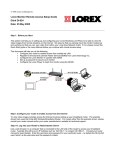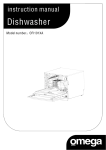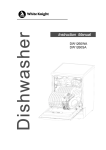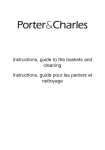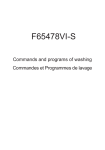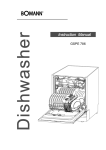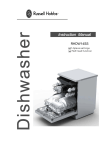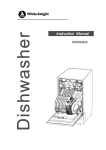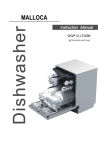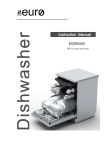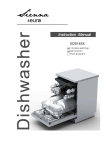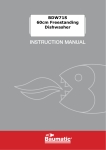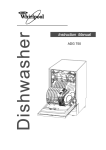Download Manual - Porter & Charles
Transcript
DW4FI DW4SS Dear Customer, Please carefully reading it before using the dishwasher will help you to use and maintain the dishwasher properly. Keep it to refer to at a later date. Pass it on to any subsequent owner of the appliance. This manual contains sections of Safety Instructions, Operating Instructions,Installation Instructions and Troubleshooting Tips, etc. Control Panel...................................................2 Dishwasher Features.................................... ...2 A、F ill the Rinse Aid Dispenser.........................3 B、Function of Detergent .............................. 4,5 Attention before or after loading the Dishwasher Ba skets..........................................................6 Loading the Basket...........................................7 Cutlery Basket................................................8 Wash Cycle Table........................................... 9 Turning on the Appliance................................ 9 Change the Programme.............. .... ................10 At the End of the Wash Cycle ...........................10 Filtering System.............................................11 Caring for the Dishwasher..................... . .........12 To review the section on Troubleshooting Tips will help you to solve some common problems by yourself . If you can not resolv e the troubles by yourself , please ask for the help o f professional tec hnicians. Positioning the Appliance................... .. ..........14 About Power Connection........................ . .......14 Water Connection.................................. . .......15 Connection of Drain Hoses..................... . .......15 Start of dishwa sher............................... .. .. ......16 Be fo re calling for se rvice............................ .....17 Error codes.................................... . ..............18 The manufacturer, following a policy of constant development a nd u pdating of the product, may make modifications without giving prior notice. When using your dishwasher, follow the precautions listed below: This appliance must be grounded. In the event of a malfunction or breakdown, grounding will reduce the risk of electric shock by providing a path of least resistance of electric current. This appliance is equipped with a cord having an equipmentgrounding conductor and a grounding plug. The plug must be plugged into an appropriate outlet that is installed and grounded in accordance with all local codes and ordinances. Do not abuse, sit on, or stand on the door or dish rack of the dishwasher. Do not place any heavy objects of stand on the door when it is open. The appliance could tip forward. When loading items to be washed: 1) Locate sharp items so that they are not likely to damage the door seal; 2) Warning: Knives and other ute nsils with sharp points must be loaded in the basket with their points down or p lace d in a horizonta l position. When using your dishwasher, you should prevent plastic items from comin g into contact with heating element.(This instruction is only applicable to machines with a visual heating element.) Check that the detergent re ceptible is empty after completion of the wash cycle. Do not wash plastic items unless they are marked dishwasher safe or the equivalent. For plastic items not so marked, check the manufacturer's recommendations. Use only detergent and rinse additives designed for an automatic dishwasher. Never use soap, laundry de terg ent, or hand washing detergent in your dishwasher. Keep these products out of the re ach of children. 1 Improper connection of the equipment-grounding conductor can result in a risk of electric shock. Check with a qualified electrician or service representative if you are in doubt whether the appliance is properly grounded. Do not modify the plug provided with the appliance; If it is not fit for the outlet. Have a proper outlet installed by a qualified electrician. Keep children away from detergent and rinse aid, keep children away from the open door of the dishwasher, there could still be some detergent left inside. This appliance is not intended for use by persons (including children )with reduced physical, sensory or mental capabilities, or lack of experience and knowledge ,unless they have been given supervision or instruction concerning use of the appliance by a person responsible for their safety. Children should be supervised to ensure that they do not play with the appliance. Dishwasher deterge nts are strongly alkaline, they can be extremely dangerous if swallowed. Avoid con tact with skin and eyes and keep children away from the dishwasher when the door is open. Th e door should not be left in th e open position since this could present a tripping hazards. If the supply cord is damaged, it must be replaced by the manufacturer or its service agent or a similarly qualified person in orde r to avoid a hazard. Please dispose of pack ing materials properly. Use the dishwasher only for its intended function. During installation, the power supply must not be exce ssiv ely or dangerously bent or flattened. Do not tamper with controls. The appliance is to be connected to the water mains u sing new hose sets and that old hose-sets sho uld not be reused. The maximum size of the dishes is 260mm. The maximum permissible inlet water pressure is 1Mpa. The minimum permissible inlet water pressure is 0.04Mpa. To get the best performance from your dishwasher, read all operating instructions before using it for the first time. Po wer indicato r: To come on when Power ON/OFF button is pressed d own . 5 Rinse Aid Wa rning Light : To be on when the rinse aid dispenser needs to be refilled. 2 ON/OFF Button: To turn on/off the power supply. 6 Program indicator : when you select washing program, the correspond light will display. 3 Delay time display : To display booking time . 7 Program button :To select washing program when press the button. 4 Delayed Start Button: Press this button to set the delaye d hours for wash ing. You can delay the start of wash ing up to 24 hours. One press on this button delays th e start of washin g by one hour. Front vie w 6 Back View 5 3 1 7 8 4 2 1 Dete rgent Dispenser 3 Filter assembly 2 Cutlery Bask et 4 Rinse A id Dispenser 9 5 Spray Arms 7 Basket 6 Cup Shelf 8 Drain pipe connector 2 9 Inlet pipe connector Rinse Aid Dispenser The rinse aid is released during the final rinse to prevent water from forming droplets on your dishes. That can leave spots and streaks. It also improves drying by allowing water to sheet off the dishes. Your dishwasher is designed to use liquid rinse aids. The rinse aid dispenser is located inside the door next to the detergent dispenser. To fill the dispenser, open the cap and pour the rinse aid into the dispenser until the level indicator turns completely black. The volume of the rins e aid container is about 110ml. Function of Rinse Aid Rinse aid is automatically added during the last rinse, ensuring thorough rinsing, and spot and streak free drying. Attention! Only use branded rinse aid for dishwasher. Never fill the rinse aid dispenser with any other substances (e.g. Dishwasher cleaning agent, liquid detergent). This would damage the appliance. When to Refill the Rinse Aid Dispenser If there is no rinse-aid warning light in the control panel, you can judge the amount of rinse-aid by the color of the optical level indicator " "located next to the cap. When th e rinse-aid container is full, the whole indicator will be dark .As the rinse -aid diminishes, the size of the dark dot decreases. You should never let the rinse aid get below 1 / 4 full. As the rinse aid d iminishes, the size o f the black dot on the rinse aid level indicator changes, as illustra ted below. Full 3 / 4 full 1 / 2 full 1 / 4 full - Should refill to eliminate spotting Empty 1 2 3 To open the dispenser, turn the cap to the "open" (left) arrow and lift it out. Pour the rinse aid into the dispenser, being careful not to overfill. Replace the cap by inserting it aligned with "open" arrow and turning it to the closed (right) arrow. Clean up any rinse aid split during filling with an abso rbent cloth to avoid excessive foaming during the next wash. Don't forget to replace the cap before you close dishwasher door. 3 Adjusting Rinse Aid Dispenser The rinse aid dispenser has four settings.The recommended setting is on "3". If the dishes still are not drying properly or are spotted, adjust the dial to the next higher number on "4". Increase the dose if there are drops of water or lime spots on the dishes after washing. Reduce it if there are sticky whitis h stains on your dishes or a bluish film on glassware or knife blades. Proper Use of Detergent Detergents with its chemical ingredients are necessary to remove dirt, crush dirt and transpo rt it out of the dishwasher. Use only deterge nt specifically made for use in dishwashers. K eep you r detergent fresh and dry. Don't put powder deterge nt in to the dispenser until you're read y to wash dishes . Detergents There are 3 sorts of d etergents 1.With phosphate and with ch lorine 2.With phosphate and without chlorine 3.Without phosphate and without chloride Normally new pulverised detergent is with out phosphate. The water so ftener function of phosphate is not given. In this case we recommend to fill salt in the salt con taine r even when the hardness of water is only 6 ° dH. If detergents without phosphate were used in case of hard water often white spots appear at dishes and glasse s. In this cas e please add mo re detergent to reach better results. Detergents without chlorine do only bleach a little. S tron g and coloured spots will not removed completely. In this c ase please choo se a prog ramme with higher Temp erature. Concentrated Detergent Based on their chemical composition, dishwasher can be split in two basic types: conventional, alkaline dete rgents with caus tic comp onents low alkalin e co ncentrated detergen ts with n atural enzymes The use of “normal ” washing programmes in co njunction with conce ntrated dete rgents reduces pollution and is good for your dishes; these wash p rogrammes are spec ially matched to the dirt-dissolving properties o f the enzymes of the concentrated de terg ent. For this reason “normal”wash programmes in which concentrated detergents are used ca n achie ve the same results that c an otherwise only be ach ieved using “heavy” program. Detergent Tablets Detergent tablets of diffe rent brands disso lve at different speeds. For this reason some detergent tablets cannot dissolve and develop the ir full cleaning power during short programmes. Therefore please use long programmes when using dete rgent tablets, to ensure the complete removal of detergent residua ls. Detergent tablets are only for the models with 3 in 1 function or 3 in 1 program. 4 Detergent Dispenser The dispenser must be refilled before the start of each wash cycle following the instructions provided in the Wash Cycle Table . Your dishwasher uses less dete rgent and rinse aid then conventional dishwasher. Generally, only one tablespoon of detergent is needed for a normal wash load. Also, more heavily so iled items need more detergent. Always a dd th e detergent just be fore starting the dish was her, otherwise it could get damp and will not dissolve properly. Amount of Detergent to Use Detergent powder Detergent tablet If the lid is closed: press release button. T he lid spring s op en. Always add the detergent just before starting each wash cycle. Only use branded detergent aid for dishwasher. Dishwasher detergent is corrosive! Take care to keep it out of reach of c hildren. Fill in detergent Fill the detergent dispenser with detergent. The marking indicate s the dosing levels , as illustrate d on right: A The place can load 15g detergent . BThe place can load 25g dete rgent . Plea se o bserve the manufacturers dosing and storage Recommendations as stated on the detergent pac kaging. Close the lid and press until it locks in place. If the dishes are heavily soiled, place an additional detergent do se in the pre-wash detergent chamber. This detergent will take effect during the pre-wash phas e. You find information about the amount o f detergent for th e single programme on the last page . Please aware, tha t according to the level soiling and the specific hardness of water differences are possible. Please observe th e manufacturer's rec ommendations on the de tergent packaging. 5 Consider buying utensils which are ide ntified as dishwasher-proof. Use a mild detergent that is de scribed as 'kind of dishes'. If necessary, seek further information from detergen t ma nufacturers. For particular items, select a p rogramme with a s low a temp erature. To prevent damage, d o not take gla ss a nd c utlery out of the dishwasher immediately after the programme h as ended. Are not suitable Are of limited suitability Cutlery with wooden, horn china or mother-of-pearl handles Plastic ite ms that are not heat resistant Older cutlery with glued parts that is not temperature resistant Bonded cutlery ite ms or dishes Pewter or cooper items crystal glass Steel items subject to rusting Wooden platters Items made from synthetic fibres Some types of glasses can become dull after a la rge number of washes Silver an d aluminium parts have a tendency to discolour during washing Glaz ed patte rns may fade if mach ine washed frequently (For best performance of the dishwasher, follow these loading guidelines. Features and appearance of baskets and cutlery baskets may vary from your model.) Scrape off any large amounts of leftover food. Soften remnants of burnt food in pans It is not necessary to rinse the dishes under running water. Place objects in the dishwasher in following way: 1.Items such as cups, glasses, pots/pans, etc. are face down. 2.Curved items, or those with recesses, should be loaded at a slant so that water can run off. 3.All utensils are stacked securely and can not tip over. 4.All utensils are placed in the way that the spray arms can rotated free ly during washing. Very small items should not be washed in the dishwasher as they could easily fall out of the basket. Load hollow items suc h as cup s, glasses, pans etc. With the opening downwards so that water can not collect in the con tainer or a deep b ase. Dishes and items of cutlery must not lie ins ide one another, or cover each oth er. To avoid damage to glasse s, th ey must not touc h. Load large ite ms which are most difficult to clea n into the basket. Long bladed knives stored in an upright position are a potential haza rd! Long and/or sharp items o f cutlery such as carving kniv es must be positioned horizonta lly in the basket. Please do not ove rload yo ur dishwasher. 6 Position the dishes and cookware so that they will not g et moved by the spra y of water. 6 5 1 1 1 2 Cups Se rving bowl 3 4 Glasses Saucers 5 6 Oval platter Fruit bowl 8 7 Brea d and butter plates Dinner plates 9 Cutlery basket Plate racks of Basket The basket is fitted with plate racks which can be stowed horizontal if required. 7 Cutlery should be pla ced in the cutlery basket with handles at the bottom. If the rack has side baskets, the spoon should be loaded individually into the appropriate slots, especially long utensils should be placed in the horizontal position at th e front o f the upper b asket as shown. 3 2 5 3 2 3 2 4 4 41 4 4 1 41 14 1 4 4 4 14 4 2 3 6 2 3 5 2 3 1 Dinner forks 2 Salad forks 3 Knives 4 Teaspoons 5 Serving spoons 6 Serving forks Do not let any item extend through bottom. Always load sharp utensils with the sharp point down! 8 ( ) Mean s: need to fill rinse into th e Rinse-Aid Dispenser. *AHAM DW-1-2005 : This program is the test cycle, the rinse-aid dis penser setting is recommended to Position 3. Pre-wash Pre-wash ( 50 ℃) Wash (55 ℃) Wash (50 ℃) Rinse Rinse (65 ℃) Drying 18g Pre-wash Pre-wash Wash (55 ℃) Rinse Rinse (65 ℃) Drying For lightly soiled loads,such as plates,glasses,bowls and lightly soiled pans. For the heaviest soiled loads, such as pots,pans,casserole dishes and dishes that have been sitting with dried food on them for a while. 100 0.40 14.5 13+13g 85 0.35 12 Pre-wash Pre-wash (50 ℃) Wash (50 ℃) Rinse Rinse (60 ℃) Drying 18g 75 0.29 12 For lightly soiled loads, such as glasses, crystal and fine china. Pre-wash Wash(50 ℃) Rinse Rinse(60 ℃) Drying 15g 70 0.27 9.7 A shorter wash for lightly soiled loads that do not need drying. Pre-wash Pre-wash(50 ℃) Wash (50 ℃) Rinse Rinse(55 ℃) 15g 45 0.22 12 Rinse Fo r the dishes that only need pre-wash. Pre-wash / 24 0.02 5 Soak To rinse dishes that you plan to wash later that day. Pre-wash / 10 0.01 2.5 Heavy Normal (*AHAM DW-1-2005 Light Glass Speed For normally soiled loads, such as pots, plates,glasses and lightly soiled pans. ) standard daily cycle. Starting a wash cycle... 1. Draw out the baske t(see the section entitled “Lo ading th e Dishwasher”); 2. Pour in the deterge nt (see th e se ction entitled “Salt, Detergent and Rinse Aid”); 3. Insert the plug into the socket. The p owe r supply is 120V/60 Hz; 4. Make sure that the water su pply is turned on to full pressure; 5. Press the on/off button t o turn on th e power supply; 6. Press the program button to select wash program yo u need Heavy->Normal->Light->Glass->Speed->Rinse->Soak 7.Close th e door, the d ishwash er will start. When you press the Start/Reset button to pause during washing, the display time will stop blinking and the program will pause and remain this cycle till you Retsar it again. 9 Premise: You can modify the washing program, When the dishwasher just runs for a short time. Otherwise, the detergent may have already been released, and the appliance may have alrea dy d rained the wash water. If this is the case, the deterg ent dispenser must be refilled (see the section entitled " Loading the Detergent " ). Open the door to pause during washing,press Program Button more than three seconds the machine will be in stand by state ,then you can change the program to the desired cycle setting (see the section entitled " Starting a wash cycle. . ." ). NOTE: If you open the doo r during washing, the machine will pause. When you close the door, the machine will keep on work ing after 10 seconds. The program lights show the state of the dishwasher: a) All program lights off---------------stand by b) One of the program lights on----------pause c) One of the program lights blinking----- run If you open the door while washing, the machine will pause. Then you close the door , the ma chine will keep on working after 10 seconds. A forgotten dish can be added any time before the detergent cup opens. 3 Add forgotten dishes. Open the door a little to stop the washing. 1 the spray arms stop working,you can open the door 2 After completely. 4 Close the door When the wo rking cycle has finished, the buzzer of dishwasher will sound 8 seconds, then stop. Turn off the appliance using the ON/OFF button, shut off the water supp ly and open the door of the dishwasher. Wait a few minutes before unloading the dishwasher to avoid handling the dishes and utensils while they are still hot and more susceptible to break age. The y will also dry better. Switch Off the Dishwasher In the digital display appears 0 (remaining programme time), only in this case the programme has ended. 1.Switch off the dishwasher by pressing the ON/OFF button. 2.Turn off the water tap! Open the door carefully. Hot dishes are sensitive to knocks. The dishes should therefore be allowed to cool down around 15 minutes before removing from the appliance. Open the dishwasher's door, leave it ajar and wait a few minutes before removing the dishes. In this way they will be cooler and the drying will be improved. Unloading the dishwasher It is normal that the dishwasher is wet inside. It is dangerous to open the door when washing, because the hot water may scald you. 10 The filter prevent larger remnants of food o r other o bje cts from getting inside the pump. The filter system con sists of a coarse filter, a flat (Main filter) and a micro filte r (fine filter). Main filter 3 1 Food and soil particles trapped by this filter are pulverized by a spe cial jet on the spray arm and washed down to drain. Fine filter 2 2 This filter ho lds soil and food residue in the sump area and prevents it from being redeposit on the dishes during wash cycle. 1 Coarse filter 3 Larger items, such as pie ces of bone or glass, that could block the drain are trap ped in the coarse filter. To re move the items cau ght b y the filter, gently squeeze the tap on the top of this filte r and lift out. Filter assembly The filter efficiently re mo ves food particle s from the wash water, allowing it to be re-cyclated during the cycle. For best performance and results, the filter assembly must be regu larly. For this reason, it is a good idea to remove the larger food particles trapp ing in the filte r after each wash cycle b y rinsin g the filter and cup under runn ing wate r. To remove the filte r assemb ly, pull on th e cu p handle in the u pwa rd direction. Never run the dishwasher without the filters in place. The d ishwasher must never b e used without the filters. Improper replacement of the filter may reduce the performance level of the appliance and damage dishes and utensils. 1 2 Step1:contrarotate the Fine filter, Step2: 3 lift it up; Step3:lift the Main filter up If do it from step1 to step 3, the filter system will be removed; while if do it from Step 3 to Step 1, the filter system will be installed. 11 Remarks: - Inspect the filters for blo cking e very time the dis hwa sher has been used. - By unscrewing the coarse filter.you can remove the filter sys tem.Remove any foo d remna nts and clean the filters under running water. The entire filter assembly should be cleaned once a week. Cleaning The Filter To clean the coarse filter and the fine filter, use a c leaning brush. Reassemble the filter parts as shown in the figures in the last page and reinsert the entire assembly in the dishwasher, positioning in its seat and pressing downward. When cleaning the filters, don't knock on them. Otherwise, the filters could be contorted and the performance of dishwasher could be debased. The control pane l can be clea ned by using a lightly dampened c loth and dry thoroughly. The exterior use a good appliance polish wax. Never use sharp objects, scouring pads or harsh cleaners on any part of the dishwasher. Cleaning The Door To cle an the edge around the door ,glide and decorative panels, you should use only a soft warm, damp cloth. To avoid penetration of water into the door lock and electrical components, do not use a spray cleaner of any kind. If you want to clean the inner surface of decorative panels, 1) remove the slide 8screws between the seat and decorative panels ; 2)then you can clean the surface, please use a damp and soft cloth; 3)then, open the doors and siding to the graph state , pull out the slide, align screw holes into the eight screws removed, please note that efforts to tighten the screws can not be too large, so as not to bore failure. Never use a spray cleaner to clean the door panel as it may damage the door loc k and electrical components. Abrasive agent or some paper to wel should not be used because of the risk of scratching or leaving spots on th e stainless steel surface. Protect Against Freezing please take fros t protection measures on dishwasher in winter. E ach time a fter washing cyc les, please operate as follows: 1.Cut off electrical power to the dishwasher. 2.Turn o ff th e water supply and disconnec t the water inlet pipe from the water valve. 3.Drain water from the inlet pipe and water valve. (Use a pan to catch the water) 4.Reconnect the water inlet pipe to the water valve. 5.Remo ve the filter at the bottom of the tub and use a sponge to use up water in sump. If your dishwasher cannot work because of the ice, please contact profe ssio nal service persons. 12 Cleaning the Spray Arms The spray arms can be easily removed for periodic cleaning of the noz zles , to prevent possible clogging. Wash them under running water and ca refu lly replace them in th eir seats, checking that their rotary movement is in no way impeded . Grasp the mid dle of the spray arm, pull it upwards to remove it. Wash the arms under a jet of runn ing water and return them carefully to their seat. After reassembly, check th at the spray arms turn free ly. Otherwise , check that they have been installed correctly. After Every Wash When it is not in need for a long time After every wash, turn off the water supply to the appliance and leave the door slightly open so that moisture and odors are not trapped inside. It is recommend that you run a was h cy cle with the dishwasher empty an d the n remove the plug from the socket, turn off the wa ter supply and leave the door of the appliance slightly open. This will help the d oor seals to ast longer and prevent odours from forming within the appliance. Remove the Plug Before cleaning or performing maintenance, always remove the plug from the socket. Moving the Appliance No Solvents or Abrasive Cleaning To cle an the e xterior a nd rubber p arts of the dishwasher, do not use solvents or abrasive cle aning products. Only use a clo th with warm so apy water. To remove spots o r stains from the surface of the interior, use a cloth da mpened with water with a little vinegar, o r a cleaning pro duct mad e specifically for dishwashers. If the appliance must be moved, try to keep it in the vertical position. If absolutely necessary, it can be positioned on its back. Seals One of the factors that cause odors to form in the dishwasher is food that remains trapped in the seals. Periodic cleaning with a damp sponge will prevent this from occurring. Electrical Shock Hazard Disconnect electrical power before installing dishwasher. The installation of the pipes and electrical equipments should be done by professionals. Failure to do so can result in death or electrical shock. The installation position of dishwasher should be near the existing inlet and drain hoses and power cord. One side of the cabinet sink should be chosen to facilitate the connection of drain hoses of the dishwasher. 13 Position the applianc e in the desired location. The back should rest against the wall behind it, and the sides, along the adjacent cabinets or wall. The dishwasher is equipped with water supply and drain hoses that can b e positioned to the right or the left to facilitate proper installation. For personal safety: DO NOT USE AN EXTENSION CORD OR AN ADAPTER PLUG WITH THIS APPLIANCE. DO NOT, UNDER ANY CIRCUMSTANCES, CUT OR REMOVE THE EARTHING CONNECTION FROM THE POWER CORD. Plea se look at the rating label to know the rating voltage and connect the dishwasher to the appropriate power supply. Use the required fuse 10 amp , time delay fuse or c ircuit breaker recommended and provide separate circuit serving only this appliance. Ensure the voltage and frequency of the power being correspond s to those on the rating plate. Only in sert the plug into an electrica l socke t which is earthed prop erly. If the electrical socket to which the appliance must be connected is not appropriate for the plug , replace the socket, rather than using a a daptors or the like as they could cause ove rheating an d burns. This appliance must be earthed. In the event of a malfunction or breakdown, earthing will reduce the risk of electric shock by providing a path of least resistance for the electric current. This appliance is equipped with a cord having an equipment-earthing conductor and an earthing plug. The plug must be plugged into an appropriate outlet that is installed and earthed in accordance with all local standards and requirements. Improper connection of the equipment earthing conductor can result in the risk of an for personal safety: electric shock. DO NOT USE AN EXTENSION CORD OR AN ADAPTER PLUG WITH THIS APPLIANCE. Check with qualified electrician or service representative if you areTHE in doubt whether the DO a NOT, UNDER ANY CIRCUMSTANCES, CUT OR REMOVE EARTHING appliance is properly earthed. CONNECTION FROM THE POWER CORD. Do not modify the plug provided with the appliance. If the plug does not fit properly to the outlet, please have a qualified electrician to install a proper outlet. 14 Insert the drain hose into a drain pipe with a minimum diameter of 4cm, or let it run into the sink, making sure to avoid bending or crimping it. Use the spe c ial plastic support that comes with the appliance. The free end of the hose must be at a height lower than 75cm and must not be immersed in water to avoid the back flow of it. The special plastic hose support must be solidly fastened to the wall to prevent the drain hose from moving and allowing water to spill outside the drain. 15 How to Drain Excess Water From Hoses If the sink is 1000 higher from the floor, the exces s water in hoses cannot be drained directly into the sink. It will b e necessary to drain excess water from hoses into a bowl or suitable container that is held outside and lower than the sink. Water Outlet Connect the water d rain hose. The drain hose must be correc tly fitted to av oid wate r leaks. En sure that the water drain hose is not kinked or squashe d. Extension Hose If you need a drain h ose extension, observe to use a similar drain hose. It must be no longer than 4 metres; otherwise the cleaning effect of the dishwasher could be reduced. The following things should be checked before starting the dishwasher. 1 The dishwasher is level and fixed properly 2 3 4 5 6 7 The inlet valve is open There is a leakage at the connections of the conducts The wires are tightly connected The power is switched on The inlet and drain hoses are knotted All packing materials and printings should be taken out from the dishwasher After installation, please make sure to keep this manual. The content of this manual is very helpful to the users. 16 Technical problems Fuse blown, or the circuit breaker tripped. Replace fuse or reset circuit breaker. Remove any other appliances sharing the same circuit with the dishwasher Power supply is not turned on. Make sure the dishwasher is turned on and the door is closed securely. Make sure the power cord is properly plugged into the wall socket. Door of dishwasher not properly closed. Closed dishwasher making sure that door latches. Kink in drain hose Check drain hose. Filter clogged. Check coarse the filter. (see section titled " Cleaning The Filter ") Kitchen sink clogged. Check kitchen sink to make sure it is draining well. If problem is kitchen sink not draining ,you may need a plumber rather than a serviceman for dishwasher. Improper detergent Use only the special dishwasher detergent to avoid suds. If this occurs, open the dishwasher and let suds evaporate. Add 1 gallon of cold water to the tub. Close and latch the dishwasher, then Start the "soak" wash cycle to drain out the water . Repeat if necessary. Spilled rinse-aid Always wipe up rinse-aid spills immediately. Detergent with colourant was used. Make sure that the detergent is the one without colourant. Hard water minerals To clean the interior, use a damp sponge with dishwasher detergent and wear rubber gloves. Never use any other cleaner than dishwasher detergent for the risk of foaming or suds. General problems The affected items are not corrosion resistant. Noise A programme was not run after dishwasher salt was added. Traces of salt have got into the wash cycle. Always run the Quick wash programme . without any crockery in the dishwasher and without selecting the Turbo function (if present), after adding dishwasher salt. The lid of softer is loose. Check the lip .Ensure the fix is fine. The spray arm is knocking against an item in a basket. Interrupt the programme, and rearrange the items which are obstructing the spray arm. Item of crockery are insecure in the wash cabinet. Interrupt the programme, and rearrange the items of crockery. This may be caused by on-site installation or the cross-section of the piping. This has no influence on dishwasher function. if in doubt, contact a suitably qualified plumber. 17 Unsatis -factory washing result Unsatis -factory drying result The dishes were not loaded correctly. See notes in " Loading the Dishwasher Baskets ". The programme was not powerful enough. Select a more intensive programme. See" Wash Cycle Table ". Not enough detergent was dispensed. Use more detergent, or change your detergent. Item are blocking the path of spray arms. Rearrange the items so that the spray can rotate freely. The filter combination in the base of wash cabinet is not clean or is not correctly fitted. This may cause the spray arm jets to get blocked. Clean and/or fit the filter combination correctly. Clean the spray arm jets. See "Cleaning the Spray Arms". Combination of soft water and too much detergent. Use less detergent if you have soft water and select a shortest cycle to wash the glassware and to get them clean. Aluminum utensils have rubbed against dishes. Use a mild abrasive cleaner to eliminate those marks. Dishes block detergent cups. Re-loading the dishes properly. Improper loading Load the dishwasher as suggested in the directions. Too little rinse-aid Increase the amount of rinse-aid/Refill the rinse-aid dispenser. Dishes are removed too soon. Do not empty your dishwasher immediately after washing. Open the door slightly so that the steam can escape. Begin unloading the dishwasher only once t he dishes are barely warm to the touch. Empty the low basket first. This prevents water form dropping off dishes in the upper basket. Wrong programme selection In short programmes the washing temperature is lower. This also lowers cleaning performance. Choose a programme with a long washing time. Using cutlery with a low-quality coating Water drainage is more difficult with these items. Cutlery or dishes of this type are not suitable for washing in the dishwasher. When some malfunctions come on, the appliance will display error codes to warn you: Longer inlet time. Faucets is not opened, or water intake is restricted, or water pressure is too low. Overflow. Some element of dishwasher leaks . If overflow occurs, turn off the main water supply before calling a service. If there is water in the base pan because of an overfill or small leak, the water should be removed before restarting the dishwasher. 18 The dimensions with “*” variable according to actual situation Water pressure: 0.04-1.0MPa Hot water connection Power supply: Max 60℃ See rating label Capacity: 6 place settings 19 Electrical, drain and water supply line entrances, both sides Space of cabinet Step 1a: If only the body into cabinets, please make this map the size of the cabinet hole. 20 Electrical, drain and water supply line entrances, both sides. Space of cabinet Step1b: If the entire decorative panel into the cabinet also, the size of a should be equal to D +3.5 + E +6; size b should be equal to C +6; Meanwhile, the cabinet around the inward booster: the bottom of the entire plane for the E-49 +3; both sides of the (C-555) / 2 +3; C, D, E and F as the second step within the relevant size decorative panels; 21 decorative panel (up) decorative panel (down) Step 2 : Weight of the decorative panel (up) should be min 3Kg-max 4Kg. Dim.A and B could be alterable by handle, Dim.C,D,E and F could be alterable by fact, If you want to make the decorative panels′size same as the front of the machine, please use the minimum size in brackets; Dim.F should be in range 16~22mm, besides the appliance assembling decorative panels. Note : If the m achine with a decorative plate, no this step. 22 Step 3: Assemble the decorative panels. If the machine with a decorative plate, no this step. Step 4: Assemble the decorative door on the dishwasher, as figure. First install sidepiece sc rew between base board and decorative panel (down),in all 4; then pull glide from out door groove ,case 8-screw between decorative panels and glide . Note: If the machine with a decorative plate ,no this step . Screw, in all 8 Screw ,in all 4 23 Step 5: Install the dishwasher in aperture, but not full, as figure, adjust screw, let its bottom align aperture’s base, then push dishwasher full. Step 6: Take out cap, a hole revealing , using screwdriver install screw, bothsides. Then recover the cap in hole. 24 Warranty Porter&Charles products are designed and built to the highest standards. We expect your appliances to provide many years of trouble free enjoyment. In the event of an appliance requiring attention, each appliance is covered by a 2 year warranty from the date of purchase. Refer to warranty policy for complete terms and conditions. Coverage is for costs of parts and labour for appliances in capital cities & metropolitan areas. We reserve the right to charge directly for handling expenses outside the metropolitan region. Porter&Charles products are supported by a national service support system. Call our customer service department for attention. Please retain your invoice to quote should you require service assistance. This will identify your product for our priority service back-up. Please attach your invoice to this manual for easy future reference. To register your purchase, you can either complete the section below to mail or fax, or register online at www.porterandcharles.ca/warranty-information. Porter&Charles 871 Cranberry Court Oakville, ON L6L 6J7 Canada Toll: 1-866-699-4973 Tel: 905-829-8389 Fax: 905-829-8409 Email: [email protected] For Service & Parts: EURO-PARTS 1-800-678-8352 Important: Please record details of your purchase below and mail or fax to Porter&Charles -----------------------------------------------------------------------------------------cut along line ------------------------------------------------------------------------------------ Name: ________________________________ Tel No _________________________________ Address: ______________________________________________________________________ City : _________________________ Prov/State:___________ Postal Code/ZIP: ____________ Where purchased: ____________________________Purchase date: _____________________ Items purchased:________________________________________________________________ Serial No’s: :___________________________________________________________________



























